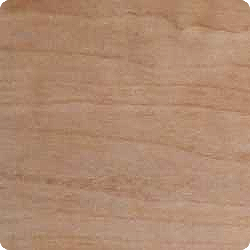Detailed Specs: Suya
Scientific Name: Pouteria speciosa
Family: Sapotaccae
Other Names: Pajura (Brazil), Chuya, Durban Pine, Por (Guyana), Bois macaye (French Guiana), Kromati kopi (Suriname)
The Tree
The tree is 0.35-0.92 meters in diameter with boles 21-21m with the tree being 25-35 meters high. The log is cylindrical with little taper and base slightly swollen.
The Wood
General Characteristics: The sapwood isn’t highly distinctive from the heartwood. It is light brown with an occasional pale purple flush. It has a straight grain with a fine texture.
Weight: Basic Specific Gravity 0.58-0.59; air- dry density 12% – 710kg/m3
Drying and Shrinkage: Shrinkage green to oven dry: radial 5.5-6.4%; tangential 11.0%; volumetric 16.5%.
Mechanical Properties: (First set of data based on the 2-cm standard; second on the 2-In. standard).
|
Moisture |
Bending Strength (psi) |
Modules of Elasticity (1000 psi) |
Maximum Crushing Strength (psi) |
| Green (74)
12% Green (30) 12% |
7,820
10,470 10,300 13,600 |
1,460
1,820 4,450 N/A |
3,760 5,800 5,150 7,150 |
Working Properties: Works readily with hand and machine tools with minimum dulling effect; reported to glue readily and polishes fairly well.
Durability: According to graveyard and pure culture tests determa’s heartwood is rated durable. It is resistant to attack by white -rot and dry-wood termites. It is also very resistant to moisture and has excellent weathering characteristics. The wood equals Honduras Mahogany in its resistance to termites and marine borers.
Distribution: The Guianas, Trinidad and the lower Amazon region. Occasional to frequent on Sandy or loamy soils in Guyana.
Preservation: The heartwood is not treatable.
Uses: This is generally a utility timber used for both interior and exterior qualities. Used for furniture, boat planking, tanks an d cooperage, joinery, heavy marine construction, turnery, parquet flooring, veneer and plywood.
References
– Chundnoff, Martin (1984), “Tropical Timbers of the World.” USDA Forest Service Ag. Handbook No.607.



